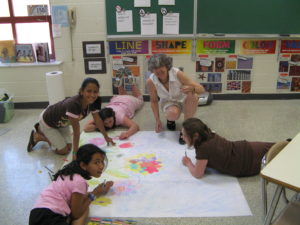I didn’t know what I was getting in to. I had never heard of this artist, an American woman, Mary Whyte, showing a large collection of watercolors at the Greenville County Museum in South Carolina. Something kind of pulled me to go and I got the last seat (one that had just opened up for me!) on a Senior Citizen bus making the trip. My, my, my…am I glad I went! Mary was the docent that day which was an extraordinary treat, and she explained the way her project “Working South” got started. So much can be gleaned when a serious artist explains her motivation, and her words confirmed the sense I had been gathering in front of her work, that this is a woman who sees deeply, and then through her formidable skill, loves well.
The very first piece I shot a photo of that day was the one I kept going back to out of the 50 large images in this collection. Her project was to document the people in the South whose livelihoods are disappearing. “The Bee Keeper’s Daughter” was a sermon in paint for me. It left me speechless, and deeply comforted. Beyond the occupation being rendered here were the symbols of her task: silent, and covered, with mystery ascending. The woman has her mouth slightly open as if in a quiet, possibly even joyful conversation. There is a rising of smoke. I guess beekeepers do that; but it too is emblematic to me. And the bee hives make a random-seeming tottering back into deep space, as if pacing toward the horizon. The bees too leave bitter streaks around her, but she is unmoved in her protective garb, her focus is elsewhere. She stands to the side. Most of Mary’s subjects are placed that way, off center. But clearly each subject is the focus of her concern, the reason she documents in color. She looks into souls with her work, and her work (way beyond her ability) looked back into mine. I got a visual that day that is sticking with me. It confirmed what I had already been pondering and then, right there it was. This is art at its best. I was supposed to be there that day. I left strangely warmed. I am one of The Bee Keeper’s Daughters. Thank-you to the Maker of Mary.
(and thank-you Mary Whyte for letting me except this here)

